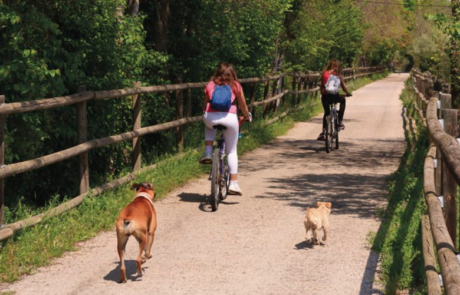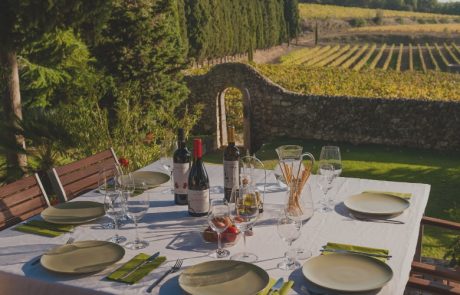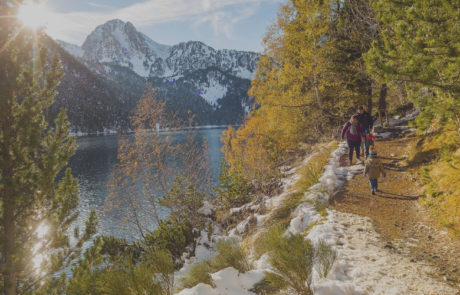March comes packed with experiences that invite you to open your eyes and take a ringside view of all the history around you. Culture is a prominent feature of our lives. It surrounds us in the form of castles converted into stately mansions like Escornalbou, in the form of paintings by Salvador Dalí, or in the form of historical settings of past battles still ingrained in our collective memory. There’s a great deal of culture to see in Cataluña and no better time to discover it than in 2018, the Year of Cultural Tourism. See you there!
Passionate about Cervera
Cervera is a land of passion. Want to check it out? Then visit us during Lent and watch the Passion of Cervera, our own version of the Passion of Christ dating back more than 500 years. Over 350 actors on stage and an entire town caught up in the event make for an exciting occasion. The play is one of the oldest in Europe and is staged at its very own venue, the purpose-built Gran Teatre.
And when it’s over, you can get a bite to eat and do some sightseeing in Cervera. Taking a stroll down Calle Major lined with elegant houses or visiting the medieval defensive wall are an excellent way to round off the day.
Be a “bell-ringer” in Os de Balaguer
Os de Balaguer doesn’t only parade its history in castles but in pealing bells as well. Its fortress, known as Os Malignum Castrum, stands at the top of a hill, looking down over the village and beckoning visitors to climb up and discover the secrets and anecdotes that have unfolded inside its walls.
The Arab castle of Os de Balaguer was fortified in 1035 to defend the Carolingian border. It formed part of a line of defences made up of numerous castles like those of Albesa, Almenar and Corbins. It also played a crucial role in the battles between the counts of Urgel and Cabrera in the 12th and 13th centuries. Today, the castle is also home to the Bell Museum of Cataluña, where you can learn the basics about bells and listen to sounds they make by becoming a “bell-ringer”.
Let the AVE take to you the world of Dalí
Never visited the Dalí Theatre-Museum in Figueras? Now there’s an added incentive because you can leave the car at home and take the AVE train. Mixing high speed and the art of Dalí might seem a daring thing to do, but just sit back and relax and 50 minutes later you’ll be immersed in the work and philosophy of one of the most fascinating artists of the 20th century.
The museum offers an insight into the unsuspected secrets of the conscious and unconscious. Home to the world’s largest Dalí collection, it features every facet of the artist, from his surrealist creations to the works he painted in the last years of his life.
Visit two Gaudí jewels without queuing
Come and visit Park Güell and the Sagrada Família without queues, transfers included. Two modernist icons await you, and you can enjoy them without having to wait in line. Park Güell is named after the Count of Güell, who originally commissioned Gaudí to design a group of high-quality homes which ended up as an architectural wonder in the middle of a natural setting. A great stairway dominated by a dragon, mosaics of ceramic tiles made with a technique known as “trencadís”, or the viaducts and leaning columns are just some of the features that embody the perfect union between nature and architecture that you’ll find in the park.
At the Sagrada Família, one of the most visited buildings in the world, prepare to gaze in awe at the 70-metre-high vaults and the Latin cross plan of a central nave flanked by four aisles, all richly decorated and filled with symbolism. And if you want to understand a little more about Gaudí’s creative process, there’s no better place to start than with the scale models and drawings on display in the church museum.
Escornalbou, from monastery to stately mansion
In Riudecanyes, Escornalbou looks down from its perch over the Costa Dorada beaches and the Priorat mountains. On these peaks with their panoramic views stands the castle-monastery of Escornalbou, which comprises the remains of two medieval buildings: the monastery of Sant Miquel, founded in 1153, and a castle built on the ruins of a Roman fortress.
During the tour you’ll learn how the owner, Eduard Toda, a diplomatic, Egyptologist and friend and classmate of Antoni Gaudí, restored it at the beginning of the 20th century to turn it into his home. At the time, it was fashionable to convert historic buildings into high-quality homes for the upper-middle classes. The tour also includes a stroll to the Font del Sarraí (Saracen Fountain) which supplied drinking water to the monastery and was the place where Toda and his friends would gather to discuss literature on summer evenings.
A castle fit for a count
A legend like that of Count Arnau, one of the quintessential figures of medieval Cataluña, would not be complete without a castle. Mataplana castle in Gombrèn (El Ripollès) was the home of this legendary figure who is sure to awaken your curiosity. According to tradition, Count Arnau was a feudal lord who mistreated his vassals, seduced ladies and defrauded soldiers.
For his sins, he was condemned to roam the earth eternally like a tormented soul, riding his horse around Gombrèn and the Gorg dels Banyuts (Cuckolds Pool), which is included in the castle tour. As well as the castle, be sure to visit the Museum of Count Arnau in Gombrèn where you can learn about literary, historical and archaeological aspects related to the castle and the Mataplana family, owners of the fortress.
Historical memory and the Battle of the Ebro
The Battle of the Ebro forms part of the past but also the present. To find out more about it, we invite to you to take a journey back in time and recover the historical memory of the battle by visiting the places where it was fought, those historical settings where the Spanish Civil War unfolded.
A stroll through the ruins and bombed-out buildings in the old village of Corbera d’Ebre will give you an idea about the scale of the air raids. Meanwhile, the Camposinas Memorial in La Fatarella is conceived as a monument to all those who took part in the battle, no matter their ideology or the side they fought on. The tour ends at Cota 402, a hill next to the local Corbera d’Ebre cemetery, site of the Republican refuge and trenches with panoramic views over the Gandesa plain.
We invite you to take cultural tour of Cataluña.

















